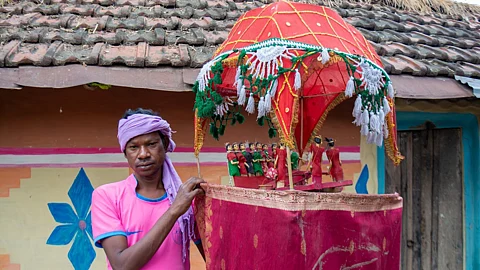
- HOMEGROWN WORLD
- #HGCREATORS
- #HGEXPLORE
- #HGVOICES
- #HGSHOP
- CAREERS
- ABOUT US
- CONTACT US

The Santhals are an ethnic group that originated in the Champa Kingdom of northern Cambodia and migrated to India around 3,000 to 4,000 years ago, settling in the Chotanagpur Plateau. In the present day and age, they are the largest ethnic minority in India and primarily reside in Jharkhand, Assam, Tripura, Bihar, Odisha, and West Bengal. The Santhals also have a significant population in Bangladesh and Nepal. They speak their own language, Santhali, which is the third most-spoken Austroasiatic language. To understand and explore indigenous communities like the Santhals, it is imperative to know about their cultural practices, which are inherently tied up with their ethnic identities. Chadar Badar, also known as Chadar Badani, a unique form of puppetry practiced by members of the Santhal community that boasts intricate mechanics, captivating performances, and a rich cultural heritage.
An article by the MAP Academy astutely describes the structural outline of this art form. Imagine a portable puppet theatre; a marvel of engineering that is condensed into a structure no taller than six feet. This is the essence of Chadar Badar. The stage itself is a platform adorned with a canopy, meticulously crafted from wood. A sturdy central stand, built from bamboo poles, holds everything together. But the true magic unfolds beneath a colorful cloth, the chadar, that conceals the lower half of the structure. Here, a complex system of levers and strings lies in wait, ready to be brought to life by the skilled puppeteer.
With remarkable dexterity, a single puppeteer breathes life into the puppets. These captivating figurines, carved from wood or bamboo, stand a mere 7 to 9 inches tall. Each puppet is a testament to meticulous craftsmanship. Their limbs are connected with tiny rods, allowing for a remarkable degree of articulation. Painted faces and vibrant costumes, fashioned from colorful fabric scraps and feathers, complete their transformation. Traditionally, there are two main types of puppets: the drummers and the dancers.
As the puppeteer manipulates the master string, the hidden levers spring into action. The drummer puppets come alive, their arms mimicking the rhythmic beats of the madhol and damak drums, creating a soundscape that perfectly complements the visual spectacle. Meanwhile, the dancer puppets gracefully sway and tilt, replicating the movements of a traditional Santhali dance. The puppeteer even controls a rotating platform, adding another layer of dynamism to the performance.
The stories enacted in Chadar Badar presentations often draw inspiration from Santhali folklore and mythology, reflecting the rich cultural tapestry of the community. But the repertoire extends beyond these traditional tales. Over time, puppeteers have incorporated elements picked up during their travels from village to village. This cultural exchange adds a unique flavor to the art form, ensuring it remains fresh and ever-evolving. Historically, Chadar Badar performances served not just as entertainment but also as a tool for social education within the Santhal community. Moral lessons and historical narratives were woven into the stories; fostering a sense of community and cultural identity.
An article by the Daricha Foundation sheds light on how the essence of Chadar Badar comes alive during vibrant festivals, particularly Dasae (popularly known as Durga Puja), Sohrai and Charok. During these festive periods, the villages come alive with celebration, and Chadar Badar performances become a central attraction. The rhythmic beats of the accompanying music – which comprises of the banam, a bowed string instrument, the tirenya, a flute, and the madhol, a drum – blend seamlessly with the puppeteer's song, creating a captivating soundscape. As the puppets come alive under the puppeteer's skillful manipulation, they narrate stories, entertain the crowds, and breathe life into the festive spirit.
Sadly, the art of Chadar Badar faces a very real threat of extinction. The intricate mechanics require a high level of skill and knowledge, traditionally passed down through generations. However, the changing times have disrupted this transmission of knowledge. Today, only a handful of puppeteers like Sukan Mardi and the late Daman Murmu have kept this tradition alive. Their dedication ensures that the magic of Chadar Badar continues to captivate audiences.
However, there are glimmers of hope. In the 1980s, artist and ethnographer Ravi Kant Dwivedi undertook the crucial task of documenting and preserving Chadar Badar. Through his meticulous efforts, the art form has been given a voice, allowing it to reach a wider audience. He has also organized training programs aimed at introducing younger generations to this unique art form. These initiatives offer a vital lifeline to Chadar Badar, and will hopefully ensure its survival for generations to come.
If you enjoyed reading this, here's more from Homegrown:
Mumbai, Attend A One-Of-A-Kind Workshop Teaching The Age-Old Tribal Art Form Of Sohrai
Inside An Audio Project Reclaiming The Cultural Identity Of Indian Tribal Communities
Inside A Pune Studio Working With Tribal & Folk Artists To Preserve Cultural Heritage
